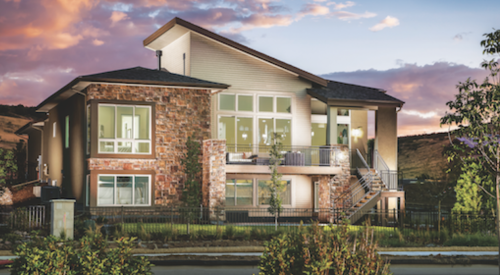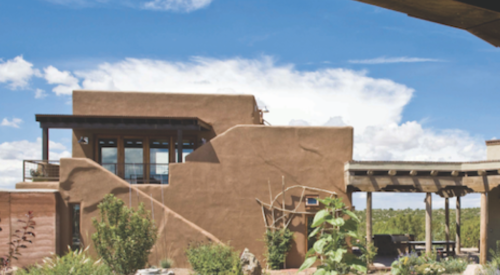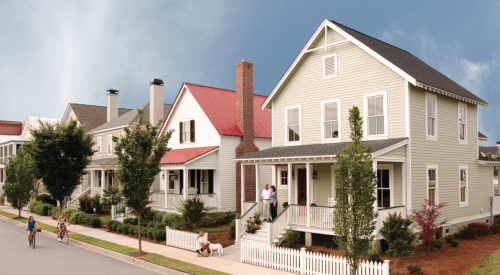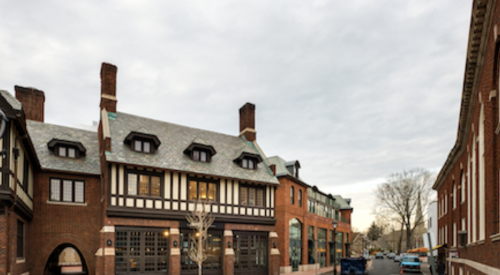|
There's little doubt that the suburban tract-house pattern of development of the 1950s is no longer viable in America. Land and gasoline aren’t the cheap commodities they once were. Consumers don’t want to spend hours commuting to and from work, and when they’re at home, they’d rather not drive 20 minutes to the gym or the nearest supermarket. With gasoline expected to climb back up to $4 or more per gallon, transportation and energy costs are going to significantly impact where people want to live. Yet, outdated approaches to residential development persist. Blame it on the economy, the regulatory climate or a lack of creativity, but something’s got to give.
We asked five leading authorities in the architecture, land planning and urban planning fields what they thought was good and bad about community design today, how it can be improved and what we can expect to see in the future.
| Hometown in Arvada, Colo., is a traditional neighborhood development that mixes three-story condos, townhomes and three-plex “mansions” with shops, restaurants and assisted-living residences. |
Echoes of the Past
The Experts: David Clinger and Kristy Riveland, David A. Clinger & Associates, Golden, Colo.
Nationally known land planner David Clinger believes that once the economy and the housing market recover, the suburban housing model that has dominated America for the last 40 years will disappear. In its place there will be smaller, mixed-use neighborhoods with higher densities and a diversity of housing types (such as Hometown, shown here). Compact single-family homes, townhomes, condominiums, rental housing, home-based businesses and neighborhood centers will reduce development costs while encouraging walking, biking and community-based recreation.
Clinger says the shift from the exurbs to urban infill sites actually started after the savings and loan crisis of the 1980s. But he expects this movement to shift into high gear as home buyers re-evaluate their priorities. “Transit-oriented developments will increase in value and popularity as well as mixed-use, walkable communities that have less emphasis on an auto-dependent lifestyle,” he says.
|
“A large percentage of residential real estate developed between now and 2025 may be modeled after the compact villages that our forefathers built when this country was first settled.” — David Clinger |
Parkways with trees, detached sidewalks and a variety of housing types will create a lower-density look and feel while yielding an average density of 9 to 11 dwelling units per acre. “These 'villages’ maximize privacy between units, provide private courtyard spaces and reduce stormwater runoff,” Clinger says. “They’re all about sustainability.” Such communities provide pedestrian access to neighborhood shops as well as affordable, low-maintenance homes, condos and apartments.
Less Pavement, More Green Space
The Expert: Rick Harrison, Rick Harrison Site Design, Golden Valley, Minn.
For Rick Harrison, the future of community design is already here. He’s probably best known as the creator of Prefurbia, a sustainable approach to suburban planning that reduces street length and creates more space (and the perception of space) without sacrificing density. Curved streets, enhanced curb appeal and better pedestrian connectivity are just a few of the benefits.
| Rick Harrison applied his Prefurbia concept to rework the land plan for Westridge Village in Eau Claire, Wis. The result was 126 more units, a central park that benefits every resident, and spacious, meandering streets that encourage walking. |
The Minneapolis-based land planner has worked on projects in 46 states and 12 countries. His designs promote panoramic views; centrally located parks and trail systems that all residents can enjoy (not just a privileged few); and meandering boulevards that invite strolling. Car clutter and the “garage grove” effect are eliminated. Expensive, underground storm sewer systems are replaced by low-cost, organic, surface-flow solutions. Westridge Village (shown) is a case in point.
Harrison claims that traditional neighborhood developments (TNDs) in outlying areas often fail, explaining, “If it takes you half an hour to get home from work, you want to have your space — not be on top of your neighbors.” He replanned a TND in Santa Fe, N.M., adding 300 homes, reducing streets by nine miles and increasing open space by 250 percent.
“No one looks at how homes are positioned on lots and the views from the windows,” Harrison says. “We’re starting from a base that’s terrible and dysfunctional. Setting a minimum density goal is not conducive to creating great neighborhoods.”
No More Housing "Corrals"
The Expert: Leland Iverson, Iverson Architects, Newport Beach, Calif.
Infill development is the gospel Lee Iverson constantly preaches to home builders, and they’re beginning to admit he’s right. Where new land is scarce or urban growth boundaries aren’t expanding, infill will become the norm, Iverson says — especially on parcels with existing low-value land uses, such as defunct shopping centers and automobile dealerships. Densities in all housing types will be higher and a mix of product types and land uses needs to be considered.
| Hawkstone, a 100-acre, pedestrian-friendly community near Spokane, Wash., mixes single-family homes, townhomes, flats, lofts and apartments. The Village Center, which includes retail, offices, cafes and health services, is on the edge of the community rather than in the middle, allowing non-residents to access and help sustain those businesses. |
Connectivity, diversity and sustainability are the guiding principles in all of Iverson’s work. Unfortunately, “people are still doing [land plans] the same old way: hiring civil engineers who don’t understand product. Product and land planning have become much more integrated.” Streets don’t need to be wide enough for a small plane to land on; narrower streets slow down traffic and reduce the amount of impervious surface. This cost-cutting measure also improves rainwater management. Hawkstone (shown) exemplifies Iverson’s principles.
“Convenience, amenities and energy efficiency will offset the desire for suburban homes where a lot of driving is required,” he says. “Since in emerging market profiles only about one-quarter of the buyers are married couples with children, the suburbs are not as attractive as before.”
And as the market shifts from move-ups to first-time buyers and empty nesters, homes and lots are getting smaller. “However, open space and community areas for meeting and interacting are needed to keep these buyers energized and connected,” says Iverson.
TNDs and TODs Gain Traction
The Experts: Tony Weremeichik, Eliza Harris and Greg Witherspoon, Canin Associates, Orlando, Fla.
| On a multi-way, transit-ready boulevard at the Restoration development in Daytona, Fla., an electric streetcar line will transport residents to work, school, shopping, parks and other on-site amenities. |
For Canin Associates, traditional neighborhood development (TND), often married with transit-oriented development (TOD), is the antidote to suburban sprawl. Greg Witherspoon, principal of Canin’s Urban Design & Planning Studio, believes builders and developers are beginning to see the benefits of TND/TOD. “You won’t see anybody doing golf courses for a long time,” says Witherspoon.
For builders, it makes sense to offer multiple housing types that appeal to a variety of demographic groups. “Diversifying their product types is going to buffer them against the marketplace,” says Eliza Harris, an urban planner with the firm. “It’s like diversifying your stock portfolio.”
Amenities, too, need to appeal to multiple generations, Witherspoon says. “For instance, trail systems that allow you get out and be active, whether you’re a Gen Y’er or a baby boomer, are becoming almost necessities in some communities.”
|
“With infill, you need to think that land planning may not be a matter of a horizontal regime where we put all the townhomes in the townhome corral and all the big houses in the big-house corral. The idea is to mix housing types within neighborhoods.” — Leland Iverson |
Harris sees big opportunities for developers in suburban retrofit. “We’ve got large, abandoned or partially vacant strip malls that require a master developer to come in and take charge. In some cases, these projects are going to involve a lot more vertical development.”
Tony Weremeichik, principal of Canin’s Architectural Design Studio, thinks local governments will begin encouraging infill development through such incentives as density bonuses, reduced impact fees and public/private partnerships.
One of Canin’s latest projects is Restoration (shown), a master plan near Daytona, Fla., that aims to create a more equitable balance of jobs and housing. Every resident will be within a 10-minute walk or streetcar ride of grocery stores, employment, schools, parks, natural open spaces and other amenities. If built as anticipated, the ratio of jobs to housing will be between 0.9 and 1.3.
Create a Sense of Place
The Expert: Randal Jackson, The Planning Center, Costa Mesa, Calif.
| The Arboretum, a master plan in North Fontana, Calif., completed in 2009, ties residential villages, schools and recreational facilities together with community gardens and a 10-acre park. Recreation centers include garden walks, themed gardens with shade pavilions and a replication of the city’s historic citrus groves. |
In Randy Jackson’s opinion, the chickens have come home to roost as far as residential community planning is concerned. “We’ve had such fervor in development over the past few years, we didn’t take the time to look at how communities live and mature and create long-term value,” Jackson says. “Now we’re paying for part of that. The communities that are still selling pretty well are the ones that have great structure and a sense of place.”
Future communities will have to be much smaller in scale, he says, because it’s unlikely developers and builders will be able to get financing for projects that comprise thousands of homes. “Neighborhoods will be definable — 30, 40 acres at the most. All of the residents will get to know each other. And we won’t worry about what’s attached and detached because the architecture alone is blurring that right now. You’re getting the sense of single-family, attached product and apartment product together in the same building.”
The Planning Center is currently designing intergenerational housing where “mom and dad, the kid that moves back home after college, and grandma can live together, yet each have their own space. When grandma passes away, they can convert her living quarters into a rental unit for the next generation.”
The company is also exploring the idea of reintroducing agriculture to suburban communities to make them sustainable. For example, a few master-planned communities have incorporated working farms and large community gardens, selling whatever is grown or raised to local residents and businesses. The Arboretum (shown) offers an already-built example.
Lastly, Jackson says, infill development is going to heat up. “Corridor planning is going to be extremely important. Cities will expand beyond their boundaries and have to come together to find solutions for housing, commercial and jobs, rather than just solving those problems individually.”












